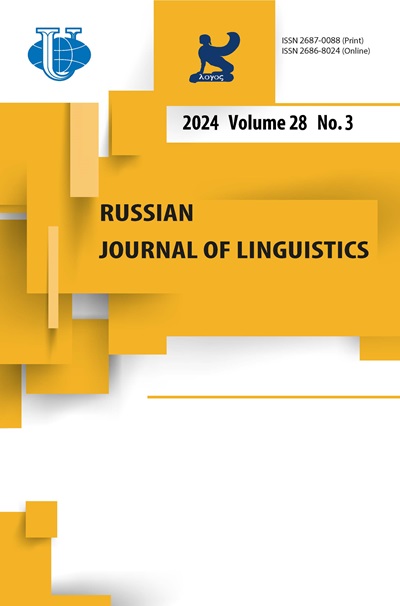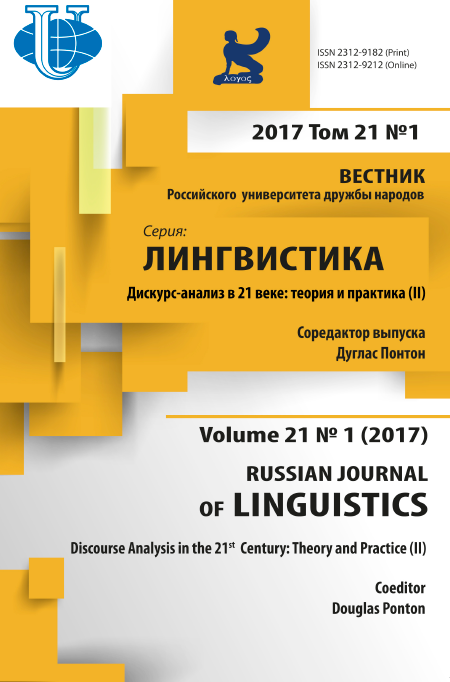Дискурсивная семантика передачи эмоционального отношения: перспективы исследования лексики)
- Авторы: Мартин Д.Р1
-
Учреждения:
- Шанхайский университет Джао Тонг
- Выпуск: Том 21, № 1 (2017): Дискурс-анализ в 21 веке: теория и практика (II)
- Страницы: 22-47
- Раздел: Статьи
- URL: https://journals.rudn.ru/linguistics/article/view/15403
- DOI: https://doi.org/10.22363/2312-9182-2017-21-1-22-47
Цитировать
Полный текст
Аннотация
В данной статье рассматриваются некоторые аспекты проблемы категоризации оценочных отношений в английском языке как части описания оценки (Appraisal), основанной на системно-функциональной теории лингвистических исследований. В рамках данной традиции рассматриваются парадигматические и синтагматические подходы к лексике, а также развитие типологических и топологических представлений о системных отношениях. В статье высказывается отношение к возможности изучения оценки на основе корпусных данных, проведенного Беднарек (Bednarek 2008). Предлагается изучение лексики, выражающей негативные эмоции (грусть) и негативные реакции на поведение (например, смущение и стыд) на основе топологического подхода. Намечаются перспективы дальнейшего изучения лексики с применением основных положений системно-функциональной лингвистики.
Ключевые слова
Об авторах
Дж Р Мартин
Шанхайский университет Джао Тонг
Email: james.martin@sydney.edu.au
Университет Сиднея NSW 2006, Австралия 200240, Шанхай, Китай, 800 Dongchuan Road
Список литературы
- Almutairi, B A. A. (2013). Visualising patterns of appraisal in texts and corpora. Text & Talk 33.4/5. 691-723
- Bazell, C. E. (1966). In J. C. Catford & M A K Halliday (Eds.) In Memory of J R Firth. London: Longman
- Bednarek, M. (2006). Evaluation in Media Discourse. Analysis of a Newspaper Corpus. London/New York: Continuum
- Bednarek, M. (2007). Polyphony in APPRAISAL; typological and topological perspectives. Linguistics and the Human Sciences 3.2. 107-136
- Bednarek, M. (2008). Emotion Talk across Corpora. London/New York: Palgrave Macmillan
- Bednarek, M. (2008). Semantic preference and semantic prosody re-examined. Corpus Linguistics and Linguistic Theory 4.2. 119-139
- Bernstein, B. (2000). Pedagogy, Symbolic Control and Identity: theory, research, critique. London: Taylor & Francis. [Revised Edition]
- de Souza, L. M. F. (2010). Interlingual re-instantiation: a model for a new and more comprehensive systemic functional perspective on translation. PhD Thesis. Universidade Federal de Santa Catarina, Brazil
- Dreyfus, S. S. (2011). In Hood & M Stenglin (Eds.) 2011 Semiotic Margins: meaning in multimodalities. London: Continuum
- Firth, J. R. (1957) A Synopsis of Linguistic Theory, 1930-1955. Studies in Linguistic Analysis (Special volume of the Philological Society). London: Blackwell. 1-31. [reprinted in F. R. Palmer 1968 [Ed.] Selected Papers of J R Firth, 1952-1959. London: Longman. 168-205]
- Halliday, M. A. K. (961). Categories of the theory of grammar. Word 17.3. 241-292
- Halliday, M. A. K. (1966). Lexis as a linguistic level. Bazell et al. 148-162
- Halliday, M. A. K. (1973). Explorations in the Functions of Language. London: Longman (Explorations in Language Study)
- Halliday, M. A. K. & J. R. Martin [Eds.] 1981 Readings in Systemic Linguistics. London: Batsford
- Halliday, M. A .K. & C M I M Matthiessen (2014). An Introduction to Functional Grammar (4th edition). London: Arnold
- Hasan, R. (1987). The grammarian's dream: lexis as most delicate grammar. M A K Halliday & R P Fawcett [Eds.] New Developments in Systemic Linguistics Vol. 1: theory and description. London: Pinter. 184-211. [reprinted in Ways of Saying: ways of meaning. 73-103]
- Hjelmslev, L. (1947). Structural analysis of language. Studia Linguistica 1.1-3. 69-78
- Hunston, S. (2011). Corpus approaches to Evaluation.: phraseology and evaluative language. London: Routledge
- Knight, N. (2013). Evaluating experience in funny ways: how friends bond through conversational humour. Text & Talk 33.4/5. 553-574
- Lamb, S. (1966). Epilegomena to a Theory of Language. Romance Philology. 531-573
- Lockwood, D. G. (1972). Introduction to Stratificational Linguistics. New York: Harcourt, Brace, Jovanovich
- Macken-Horarik, M. & J.R. Martin (Eds.) 2003. Special issue of Text 23/2 on ‘Appraisal’
- Malinowski, B. (1935). Coral Gardens and their Magic: a study of the methods of tilling the soil and of agricultural rites in the Trobriand Islands (Volume Two: The Language of Magic and Gardening). London: George Allen & Unwin
- Martin, J R (1992). English Text: system and structure. Amsterdam: Benjamins
- Martin, J R (1997). ‘Analysing genre: functional parameters’. In: Christie, F. & J. Martin (eds). Genres and Institutions: Social Processes in the Workplace and School. London: Cassell: 3-39
- Martin, J R (2000). Beyond exchange: appraisal systems in English. S Hunston & G Thompson [eds.] Evaluation in Text: Authorial Stance and the Construction of Discourse. Oxford: OUP. 142-175
- Martin, J R (2010a). Systemic Functional Linguistic Theory. Vol. 1 in the Collected Works of J R Martin (Wang Zhenhua Ed.). Shanghai: Shanghai Jiao Tong University Press
- Martin, J R (2010b). Semantic variation: modelling system, text and affiliation in social semiosis. M Bednarek & J R Martin [Eds.] New Discourse on Language: functional perspectives on multimodality, identity and affiliation. London: Continuum. 1-34
- Martin, J R (2011). Multimodal semiotics: theoretical challenges. Dreyfus et al. 243-270
- Martin, J R (2013). Systemic Functional Grammar: a next step into the theory - axial relations. (Chinese translation and extensions by Wang Pin & Zhu Yongsheng). Beijing: Higher Education Press
- Martin, J R & C M I M Matthiessen (1991). Systemic typology and topology. F. Christie [Ed.] Literacy in Social Processes: papers from the inaugural Australian Systemic Linguistics Conference, held at Deakin University, January 1990. Darwin: Centre for Studies in Language in Education, Northern Territory University. 1991. 345-383. [Reprinted in Martin 2010. 167-215]
- Martin, J R & D Rose (2003). Working with Discourse: meaning beyond the. London: Continuum. [2nd revised edition 2007]
- Martin, J R & D Rose (2008). Genre Relations: mapping culture. London: Equinox
- Martin, J R & P.R.R. White (2005). The Language of Evaluation: Appraisal in English. London/New York: Palgrave/Macmillan
- Martin, J R, Zappavigna M., Dwyer P. & Cleirigh C. (2013). Users in uses of language: embodied identity in Youth Justice Conferencing. Text & Talk 33.4/5. 467-496
- Maton, K. (2014). Knowledge and Knowers: Towards realist sociology of education. London: Routledge
- Matthiessen, C. M I M & M A K Halliday (2009). Systemic functional grammar: a first step into the theory. Beijing: Higher Education Press
- Matthiessen, C. M I M & C. Nesbitt (1996). On the idea of theory-neutral descriptions. In R Hasan, C. Cloran, & D. Butt [Eds.] Functional descriptions: theory in practice. 38-84. Amsterdam: Benjamins
- McMurtie, R.J. (2013). Spatiogrammatics: a social semiotic perspective on moving bodies transforming the meaning potential of space. PhD Thesis: University of New South Wales
- Muller, J. (2007). On splitting hairs: hierarchy, knowledge and the school curriculum. In Christie & Martin. 64-86
- Painter, C. (2003). Developing attitude: an ontogenetic perspective on APPRAISAL. Text 23.2. 183-210
- Sinclair, J. McH (1966). Beginning the study of lexis. Bazell et al. 410-430
- Stenglin, M (2009). Space Odyssey: towards a social semiotic model of three-dimensional space. Visual Communication 8.1. 39-64
- Stewart, D. (2010). Semantic Prosody: a critical evaluation. London: Routledge
- Tucker, G. H. (1998). The Lexicogrammar of Adjectives: a Systemic Functional approach to lexis. London: Cassell
- van Leeuwen, T. (2009). Parametric systems: the case of voice quality. C. Jewitt [Ed.] The Routledge Handbook of Multimodal Analysis Oxon/New York: Routledge. 68-77
- Whittaker, R. M. O’Donnell & A. McCabe [Eds.] (2009) Advances in Language and Education. London: Continuum
- Wolfer, D. & Harrison-Lever, B. (Illus.) (2005). Photographs in the Mud. Fremantle, W.A: Fremantle Arts Centre Press
- Zappavigna, M. (2011). Visualizing logogenesis: preserving the dynamics of meaning. Dreyfus et al. 211-228

















